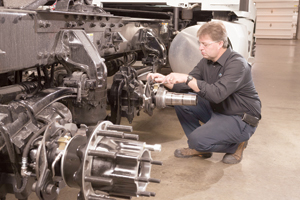Materials and Design Changes Shed Weight From Class 8 Tractors

This story appears in the Jan. 23 print edition of Equipment & Maintenance Update, a supplement to Transport Topics.
Equipment and component manufacturers are using new designs and materials such as aluminum to remove weight from Class 8 tractors, which helps fleets increase payload and maximize fuel efficiency. This movement toward lighter materials also helps original equipment manufacturers offset the additional weight from emission-reduction systems and aerodynamic devices that help them meet federal greenhouse-gas regulations.
“As more weight is added to the vehicle, we’re looking for ways to neutralize that weight by reducing the weight of our products,” said Craig Kessler, vice president of engineering for wheels at Accuride Corp., a component manufacturer.
C.R. England, a refrigerated carrier based in Salt Lake City, has calculated the fuel economy impact of a pound on its total cost of ownership. It estimates it at 98 cents for a three-year trade cycle for a tractor.
“You need to know what that number is when you’re spec’ing a piece of equipment so you know the value of that weight savings,” said Ron Hall, vice president of equipment and fuel at C.R. England, which ranks No. 23 on the Transport Topics Top 100 list of the largest for-hire carriers in the United States and Canada.
Andrew Halonen, president of Mayflower Consulting and co-author of a lightweighting study published by the North American Council for Freight Efficiency, said the amount carriers are willing to pay is dictated by what they haul.
“You have 100 out of 100 people who want weight reduction but only one out of 100 who will pay for it,” he said.
Halonen said the tank truck market will pay up to $12 a pound for weight savings, reefer carriers are willing pay $2 to $4 per pound, but dry van operations will pay only $2 per pound or less.
JD Rutt, vice president of business development for Sapa Extrusions, a manufacturer of aluminum extrusion products and chairman of the heavy-truck working group for the Aluminum Association, said a move to aluminum can result in a 25% to 30% reduction in weight on a given part.
C.R. England has taken several steps to remove about 1,000 pounds from its intermodal day cab tractors, Hall said. This includes removing the passenger seat, spec’ing a smaller engine and using an aluminum fifth wheel.
OEMs and fleets want decreased weight, said Bryan Redeker, product manager for SAF-Holland Inc., a component manufacturer. “It helps when you hear it from both sides of the spectrum,” he said.
SAF-Holland’s aluminum top plate fifth wheel, FWAL, for example, saves about 100 pounds, he said.
In certain trucking sectors, such as bulk hauling, that can add up. Redeker estimates a bulk hauler handling two loads daily can carry an additional 73,000 pounds annually.
Dupré Logistics, a bulk carrier based in Lafayette, Louisiana, specs aluminum fifth wheels.
“Lightweight equipment is very important to our operations because we often want to achieve the maximum payload,” said Scott Allen, director of fleet assets and maintenance at the company, which ranks No. 97 on the for-hire TT100.
Paul Rosa, senior vice president of procurement and fleet planning for Penske Truck Leasing, based in Reading, Pennsylvania, said an aluminum fifth wheel makes sense when a tractor is coupled to the same trailer the majority of the time. “It would be riskier to use if you have a high drop and hook operation where a driver could misalign when coupling. The trailer king pin could damage the aluminum fifth wheel, requiring replacement of the top plate,” he said.
Aluminum is providing savings in other truck equipment, too.
Jim McManus, national sales director for metal matrix composite technologies at Accuride Corp., said the company plans to release an aluminum composite brake drum in 2018 that weighs 62 pounds, a significant reduction compared with a typical cast-iron drum that weighs 113 pounds.
Aluminum drive axles also are an option, but very few people will pay for them, said Steve Slesinski, director of global product strategy, planning and management at Dana Corp.
On a tractor, Arconic’s lightest forged aluminum wheel offering can save up to 300 pounds per tractor, said Merrick Murphy, president of wheel and transportation products at Arconic, which manufactures Alcoa-brand wheels. The weight reduction is a result of both design and material. Alcoa Inc. split into two companies — Alcoa Corp. and Arconic on Nov. 1.
Trucks, as part of its SuperTruck design, reduced the weight of the chassis by 700 pounds by replacing steel with aluminum, said Derek Rotz, director of advanced engineering for parent company Daimler Trucks North America. Additional weight savings were achieved by redesigning the cross members and shortening the wheelbase.
The costs of lighter weight materials vary, Rotz said. “For example, switching from vertical to horizontal exhaust should save weight and money. Whereas, switching from a manual transmission to automated transmission will cost more up front,” he said.
Several commercially viable technologies developed in conjunction with the SuperTruck program have been introduced in DTNA production vehicles, including a 6x2 axle configuration, horizontal exhaust and smaller fuel tanks, Rotz said.
Meanwhile, Eaton Corp. has reduced the weight of its transmissions though different materials, including aluminum, and structural improvements, said Mihai Dorobantu, director of technology planning and government affairs.
Dan Caranno, director of fleet maintenance at less-than-truckload carrier A. Duie Pyle, based in West Chester, Pennsylvania, said, there is no single silver bullet to trim vehicle weight.
“You’re inching 10 pounds here, 20 pounds there,” he said. “You’re trying to shave the weight but not affect the integrity of the vehicle.”
In its weight-sensitive dedicated accounts, A. Duie Pyle and has opted for a 13-liter engine instead of a 15-liter to save weight, Caranno said.
A. Duie Pyle ranks No. 73 on the for-hire TT100.
But not all fleets can move away from a 15-liter engine. Engine maker Cummins Inc. has developed a single module after-treatment system for its 2017 15-liter engines that will result in 80 to 100 pounds in weight savings, said Clint Garrett, product manager for Cummins’ X15 and ISX15 engines.
Katherine Scheidt, product manager for Cummins X12 and ISX12 engines, said the company’s next generation 12-liter product will also have a lighter weight aftertreatment system and has achieved additional weight savings through design and composites on some components, such as the valve cover and oil pans.
Overall, design changes rather than material changes can help manage cost, said Keith McComsey, director of marketing and customer solutions for Bendix Spicer Foundation Brake. Bendix offers low-weight brake chambers, which save 1.5 pounds per chamber, or about six pounds per vehicle.
Dorobantu said Eaton has saved weight by combining multiple connections within the same assembly, such as valve actuation with the engine brake technology.
Meritor Inc. also has removed weight by turning two separate components into one. “With our MFS+ front axle, we’ve taken the knuckle and tie rod arm and made them one part. That eliminated fasteners,” said John Bennett, general manager for global product strategy.
Meritor said its 6x2 axle saves 400 pounds compared with a typical 6x4 configuration. When coupled with single wide-base tires versus standard duals, the savings can reach 800 pounds. John Nelligan, vice president of sales and service, said Meritor’s RT-145A axle saves about 60 pounds due to the aluminum.
Through design, Dana removed about 40 pounds from the Spicer AdvanTEK 40 tandem drive axle. Dana Inc. has also integrated the ADB22X air disk brake mounting into the steer axle knuckle, saving 76 pounds compared with a bolted-on design on 13,200-pound rated steer axles. The company is launching a new drive shaft this month that will reduce weight by 20 to 30 pounds depending on the application, said Tom Bosler, director of global product planning at Dana’s commercial vehicle products group.
SAF-Holland has taken weight out of its vocational air suspensions, with the Neway ADZ suspensions saving about 300 pounds per tandem compared with the Neway AD suspension, said Jason Heath, product manager of Neway truck, bus and RV suspensions.
Ultimately, fleets said the available weight saving options have to make sense for their operations.
“We make recommendations of lightweight components that we feel offer the best value without increasing the likelihood of added expense due to a higher damage risk,” Penske’s Rosa said.




